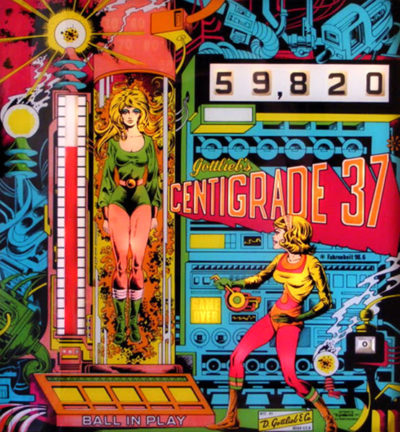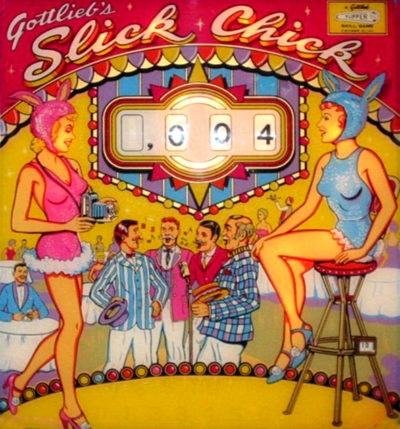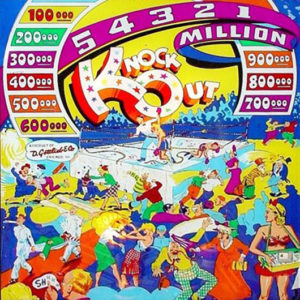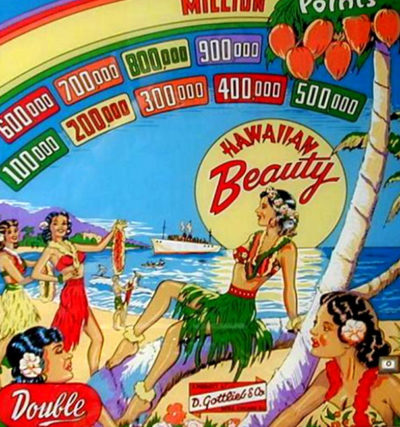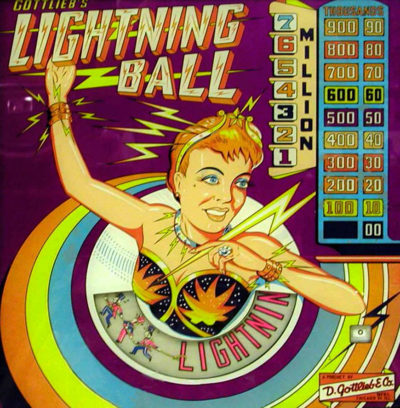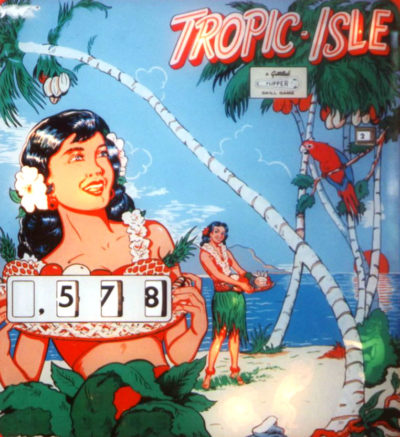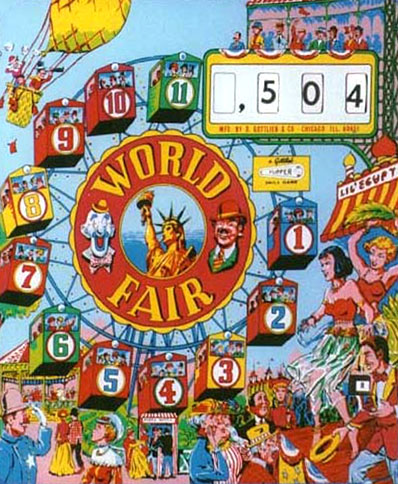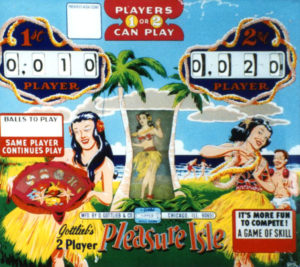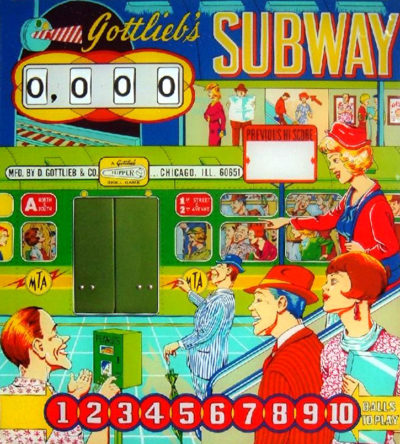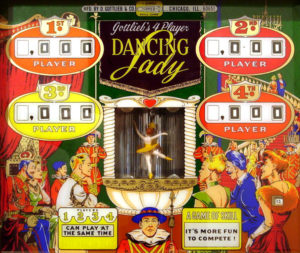-
This game scores as the #10 most desirable game of the ’70s. It came out in August, designed by Ed Krynski and Allen Edwell with artwork by Gordon Morrison. Backbox animation is included in the game. A giant thermometer advances when drop targets are hit and by rolling over the rollovers. If the thermometer is advanced to the top, the special lights on the eject hole. A, B, C and D rollovers, if hit, advances the thermometer 5 advances. If a player completes all the letters, he gets 5,000 points in the eject hole. A double bonus feature is present also. All in all, a very fast-paced game. Artists, as a general rule, didn’t help design playfields. They were given the game mechanically more or less completed and had to invent the graphics and theme on their own.This April release was produced in a quantity of 4,550 units. Wayne Neyens designed the machine with Roy Parker doing the artwork. The art theme of the machine is Playboy bunnies as the Playboy Corporation opened a big Playboy club in the Chicago area in 1960 which was a real hit. The object of the game is to light the bumpers spelling out “Slick Chick.” It’s a tough game to master. Each time the sequence is completed, a rollover lights on the play field to score 10 points. If you can complete all five roll-overs, the center gobble hole lights to score a replay. Four roll-overs on the side of the play field numbered one to four also score a replay if hit in sequence. Score is your other goal toward replays. I remember playing this game at the arcades and it was very hard to achieve a winning combination. It is considered one of Wayne Neyens’ best games and one of his favorites in the annals of pinball design.This game was produced in December of the year and designed by Harry Mabs with artwork by Roy Parker. 3,000 of these machines were made. The unique feature built into this machine is the animation unit in the top center of the play field. Two mechanical men are represented as boxers in a boxing match. Lights illuminate the bout when a knockout is scored by rolling over a “KO” rollover, a “KO” target, or completing bumpers 1 to 5. This game is one of the first examples of pinball animation. Another feature of the game is the pop-up bar at the bottom of the play field, preventing you from losing your ball in play for an extended period. Since the gap between the flippers is so massive, this addendum to the play field was installed to prolong the play period of the ball. A special feature is included in the game as well as a replay if 15 knockdowns are scored in one game and a replay for every knockdown scored thereafter.If there was a very pretty game manufactured in the ‘50s, this is it! Hawaiian Beauty was designed by Wayne Neyens with art package by none other than Roy Parker. 900 of these machines were screwed together in the Chicago factory. The game was initially called “Monkey Shine” but was later changed. This game also features the infamous “double” award. If you inset two nickels at the beginning of the game instead of the usual nickel, each won replay would score two games or double the winnings instead of one game. More coins in the coinbox was the hope of the arcade owners. The playfield is interesting in this game. Two blocked gobble holes at the top of the playfield would score 500,000 points and light lower side exit special lanes for replays. Hitting the 1-6 sequence at the top of the playfield would advance the rollovers to score 100,000 points if rolled over. Points as well as score won games.Wayne Neyens and Roy Parker again teamed up to create this pretty late-‘50s pin with an animated backglass. 950 units were made. The playfield has two gobble holes, which award 100,000 points for each rollover completed. If all six rollovers are made, a replay is awarded and the gobble holes are special holes. The main feature of the game is advancing the lightning ball backglass spelling. Each time you make the three colors on the playfield via rebound rubber or rollovers, the unit advances one step. If you are skillful enough to complete the lightning ball spellout, a replay is awarded, and each time you make the three colors to advance the letter, another replay is added. It’s not an easy task to complete. There’s always beating the game by scoring or matching. This game was somewhat retro as it has backglass light scoring, since Gottlieb already used reel scoring.This Gottlieb game is one of the five in the museum of the “flipper” series from Gottlieb. These games are all add-a-ball games. The layout of this game parallels a future Gottlieb classic by the name of “Buckaroo” (also in the museum). 1,550 of these machines were manufactured. Wayne Neyens designed the game and Roy Parker established the art package. Fifteen targets on the roto-target are present and spinning the roto would bring up new numbers to complete. If you are skillful enough to sequence four numbers in a row, an extra ball is awarded. The bull’s-eye target awards an extra ball also. Each time an extra ball is awarded, the backglass animation activates. The cowboy shoots at the targets, which causes them to spin. No match feature here and tilting the game forfeits the ball in play as well as a future ball in play.Wayne Neyens designed this classic with Roy Parker penning the artwork. 2,700 of these were fabricated. This game has a holdover feature, which holds the monkeys’ positioning on the backglass from game to game. If you’re skillful enough to hit the A, B, C, and D targets, a monkey is advanced up the tree on the backglass. If one monkey makes it to the top, one replay is awarded: two monkeys score two replays, and three monkeys score three replays. Obviously if you pass this game and notice the third monkey nearing the top, feeding the coin slot was a natural for your just reward. Rolling over the 1 – 5 rollovers at the top of the playfield lights the side specials and awards 200 points once you drain the ball. A nice, well balanced game and quite a challenge not to lose your ball in play.This classic game is currently rated as the number two game of its generation. 4,650 units were produced in April of the year with design credits going to Roy Parker for artwork and Wayne Neyens for design. The game was produced to coincide with the New York World’s Fair of 1964-1965. The 11 ferris wheel cars depicted on the backglass are represented on the play field by roll overs and targets. Hitting a numbered car lights the corresponding backglass car. The interesting gadget developed for this game is the center spinning disc (i.e. ferris wheel) in the middle of the game. By spinning the disc, one randomly spots a ferris wheel car on the backglass. Completing all the cars awards a replay and the randomly advancing lighting of a rollover which, if you’re skilled enough, would award a replay if hit. Score is another way to conquer the machine. Enjoy trying your hand at this classic machine.The last game of ’65 is a two-player add-a-ball game. It was designed by Ed Krynski with art by Roy Parker. A replay model also exists by the name of Paradise. Production run was a meager 265 units; the replay game had 2,100 units fabricated. The animated backglass on this game contains a dancing hula girl. When extra balls are won, they are represented as beach balls on the backglass. If you complete the sequence A, B, C, and D in that order, a free ball is your reward. Roto lights advance and indicate the value of the kickout holes. Points set by the operator award free balls also. An interesting guide rail is on either side of the flipper drains, a variation on a theme. This game is very rare due to its low production numbers.This game is a classic and is rated # 5 in collectible machines of the ‘60s. The game was created by Wayne Neyens with artwork by Roy Parker. Production run was 2,875 units. The main action in the game comes from the four in-line kickout holes set across the center playfield. The object of the machine is to hit a suit of four cards vertically under the kickout holes. If you get all four, a hole will randomly light up to score a free game (i.e., a special). The challenge here is to sink the ball in the kickout holes once a special is lit. All four holes can light up if you’re lucky enough to score all 16 cards. Finally, another special in the top rollover lanes randomly lights if you score just the four top cards on the pattern of cards. Score also was a factor as dropping balls in the kickout holes with many cards lit scored a lot of points very quickly.Gottlieb Subway arrived in October ’66. It was designed by the classic team of Ed Krynski and art by Gordon Morison. This add-a-ball version of the game closely resembled the replay version by the name of Crosstown. This wedgehead Gottlieb has an animated backglass. Every time 100 points are scored, the door of the subway opens, revealing passengers jammed together in a comical pose. The center target is where all the action is in the game. If you happened to match the two columns horizontally by advancing the columns by hitting various spots on the game and hit the center target, the award indicated would be given. Otherwise 10 points were awarded. This game was a tough game to play, as the opening between the flippers was rather large and a hit to the center target would regularly cost you a lost ball.This four-player machine was produced in November of the year with 2,675 units fabricated. It was designed by Ed Krynski with art penned by Art Stenholm. Technically, a couple of firsts were incorporated into this machine for Gottlieb, like an automatic ball lifter, decagon score reels and carousel roto-targets. The carousel roto-target allow one to shoot at one or two targets at a time if flipper savvy. The star on the unit awards an extra ball. The object of the game is to achieve high-enough scores to award replays. The big points are awarded when the two 10x lights under a roto-target light up, awarding 100 times the value of the number hit. The most attractive gadget built into the game is the dancing ballerina in the backglass, which dances when certain elements of the play field are achieved. A highly collectible game in its own right.
-
This game scores as the #10 most desirable game of the ’70s. It came out in August, designed by Ed Krynski and Allen Edwell with artwork by Gordon Morrison. Backbox animation is included in the game. A giant thermometer advances when drop targets are hit and by rolling over the rollovers. If the thermometer is advanced to the top, the special lights on the eject hole. A, B, C and D rollovers, if hit, advances the thermometer 5 advances. If a player completes all the letters, he gets 5,000 points in the eject hole. A double bonus feature is present also. All in all, a very fast-paced game. Artists, as a general rule, didn’t help design playfields. They were given the game mechanically more or less completed and had to invent the graphics and theme on their own.



